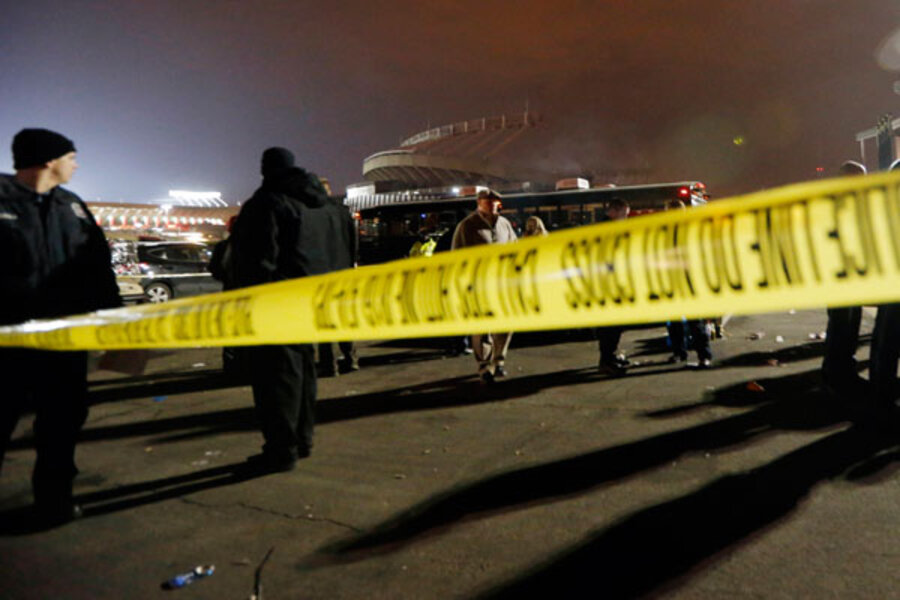Arrowhead homicide? Killing highlights postgame fan violence.
Loading...
The death of a man outside Arrowhead Stadium in Kansas City, Mo., Sunday after a Kansas City Chiefs football game is heightening awareness of a what experts call a gap in domestic security: parking lots before and after major events.
For years, event producers and venue owners have concentrated their resources on providing security inside the venue, which is considered a much more controlled environment, largely ignoring the parking lots outside.
“They continue to ignore the parking lot, which then can become a no man’s land when it come to safety and security. We see this constantly,” says Paul Wertheimer, founder of Crowd Management Strategies, based in Los Angeles.
Kansas City police say three men are in custody following an altercation involving a car break-in gone wrong in the stadium parking lot. On his Twitter feed, Kansas City Police Chief Darryl Forte said the “incident did not involve any fan rivalry.” The death is being treated as a homicide.
The increase in security measures at airports, shopping malls, and rail stations, has already raised questions about whether Americans are sacrificing too many civil liberties for their own safety. But Mr. Wertheimer suggests that parking lots, which attract tens of thousands of people, need to have camera monitoring and regular patrols “before, during, and after the event.” Too often, he says, security teams disperse soon after the event is over.
Costs clearly come into the equation, he adds.
“It costs money and nobody wants to pay it,” Wertheimer says. “It’s not that the live entertainment or professional sports [organizer] doesn’t know these things happen. My assessment is they make a calculated decision that they don’t want to spend the money.”
According to “Spectator Violence in Stadiums,” a 2008 report by the Center for Problem-Oriented Policing, a division of the US Department of Justice, the four most common problems encountered among stadium staff in incidents of off-field violence are lack of “training, experience, presence, and communication.”
“In general, venues that employ staff with little training and experience, fail to provide an adequate number of personnel, and do not provide personnel with clear directives and lines of communication are more likely to experience problems with spectator violence,” the report reads.
Private security companies are “less effective” than venue personnel because they are often hired to police single events and are unfamiliar with venues. Plus, they often lack the training necessary to “manage crowded parking environments” or lines that form due to day-of-game giveaways or other promotions that are common at sporting events.
The death at Arrowhead Stadium is not an isolated one in Kansas City. Last December, Chiefs linebacker Jovan Belcher killed himself outside the stadium in front of his head coach and other team officials. Last September, a man shot and wounded a woman and then killed himself in the parking lot outside a Kansas City Royals game.
More recently, on Thanksgiving, a man was beaten unconscious outside AT&T Stadium in Dallas following a game between the Dallas Cowboys and the Oakland Raiders. In September, a Los Angeles Dodgers fan was fatally stabbed outside AT&T Park in San Francisco; that incident followed days after a man received a severe beating outside Candlestick Park where the San Francisco 49ers played.
After the stabbing, the San Francisco Police Department announced it would increase its presence at the ballpark. “The rivalry needs to stay out on the ball field, not in the stands, and not on the street,” Sgt. Danielle Newman told the local ABC News outlet.
For obvious reasons, alcohol consumption is often a focus, especially since tailgating takes place hours before and after games.
“Unfortunately, a lot of fans drink before they even arrive inside the stadium … most of the drinking occurs in the parking lots,” says Eloy Nuñez, a criminal justice professor at Saint Leo University near Tampa, Fla., who served as the principal planner of security at Super Bowl XLI in 2006.
Dr. Nuñez says even though sports complexes try to cut down on violent behavior by selling beer in soft containers and stopping sales early, “there is no foolproof way to screen all intoxicated fans.”
Another problem, he says, is the relative ease with which fans can smuggle their own alcohol through the gates.
“That practice cannot be stopped 100 percent without resorting to more invasive searches, which is not likely,” he says.








